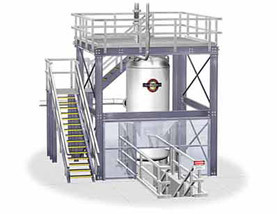
The lab's 900 MHz NMR magnet produces a very homogenous field.
You look on the carton of milk it will say it's homogenized. Believe it or not, homogeneity in a magnet is almost the same thing as homogenized milk. If the milk is not homogenized, there will be a layer of cream on top. Well, in a magnet, if the magnet is homogenized, the field will be the same all over your sample, from the top to the bottom. If the magnet is not homogenized, the field might be stronger at the top and weaker at the bottom. A homogenized field can give us a much sharper resonance line, give us much more information about the chemistry or physics of the sample.
Magnetic resonance doesn't happen unless you're in a field. And the energy or frequency associated with the resonance depends directly on the field. So if the field is not uniform over the sample, the energy will be absorbed over a band of frequencies instead of at a single frequency. When those start overlapping, then we can't learn very much about the sample. So having a homogeneous field keeps those bands of frequencies, which we call resonance lines, separated.
The resistive magnets that we have at the lab have moderate homogeneity, and the superconducting magnets have much better homogeneity. That homogeneity is further improved with correction coils inside the magnet.


